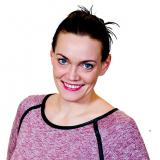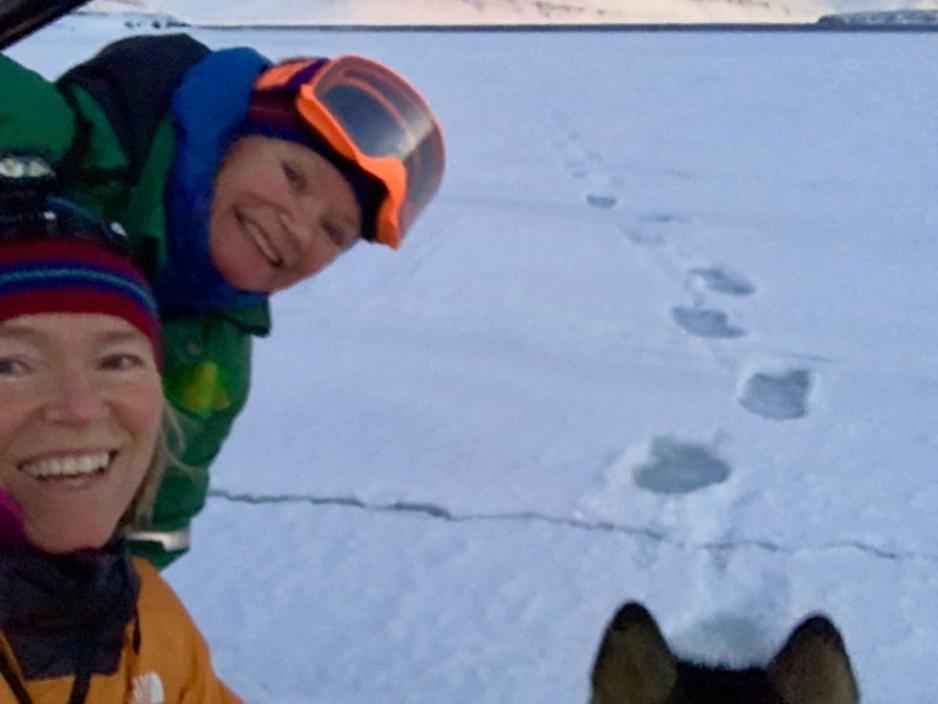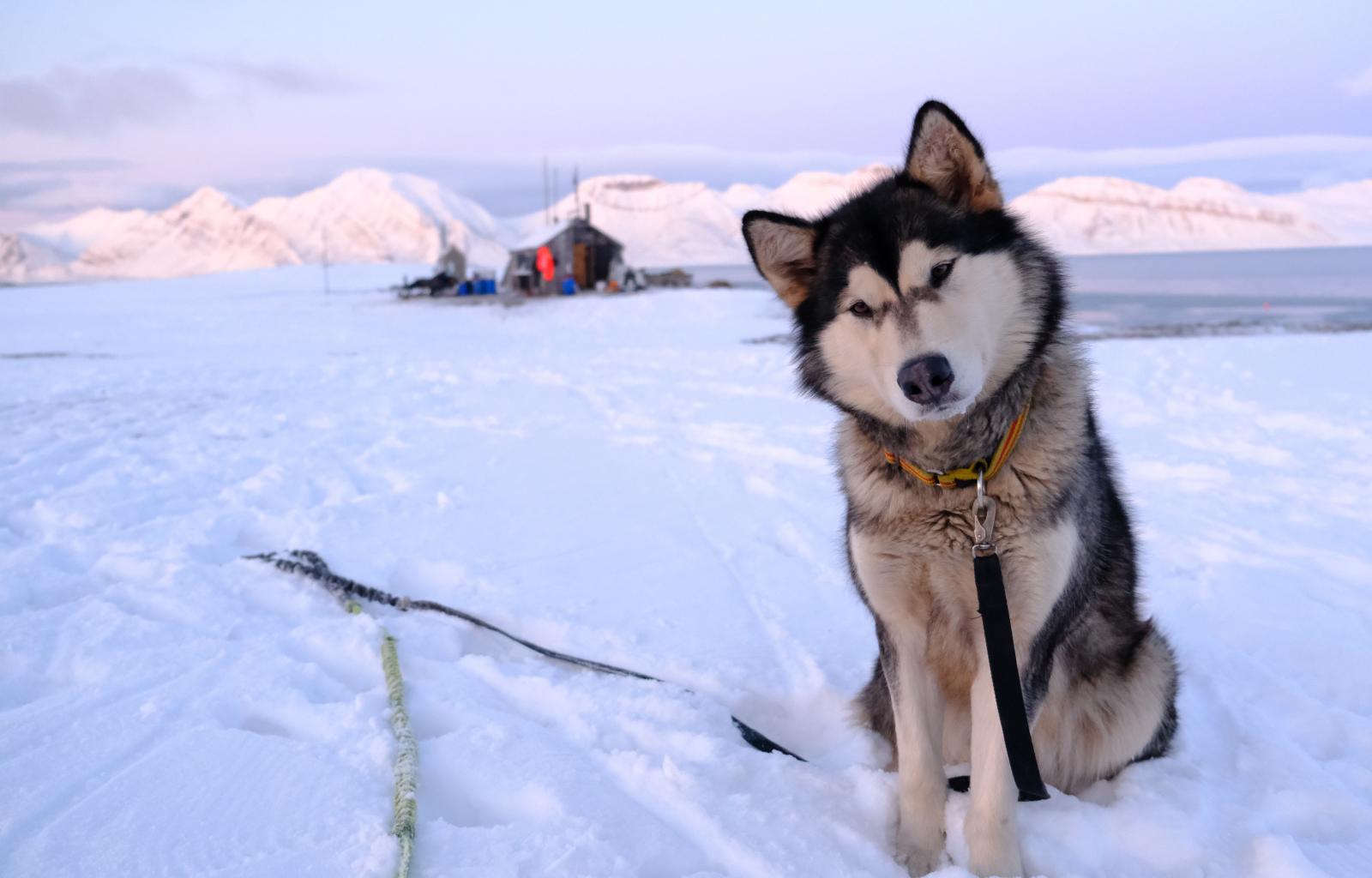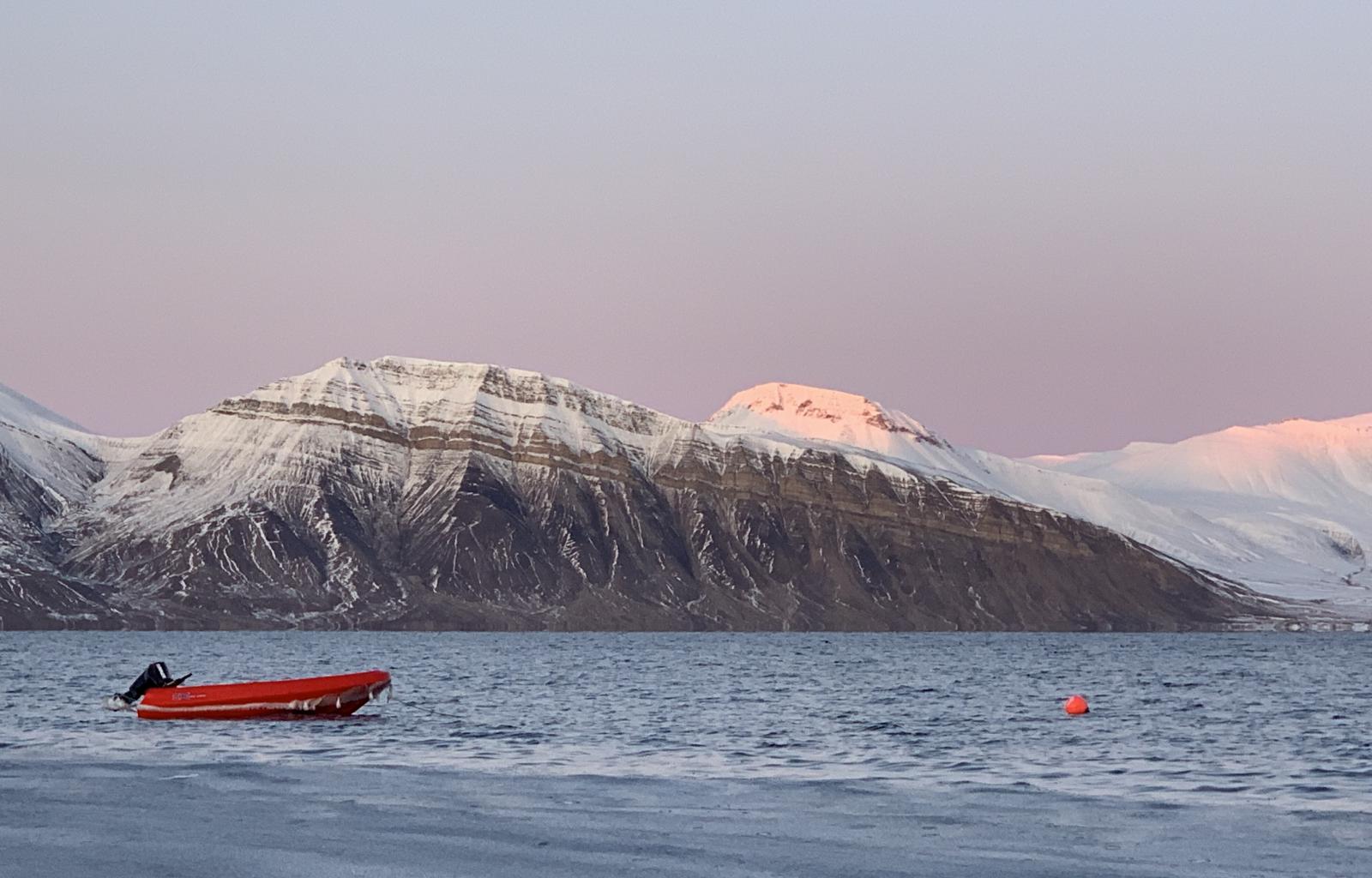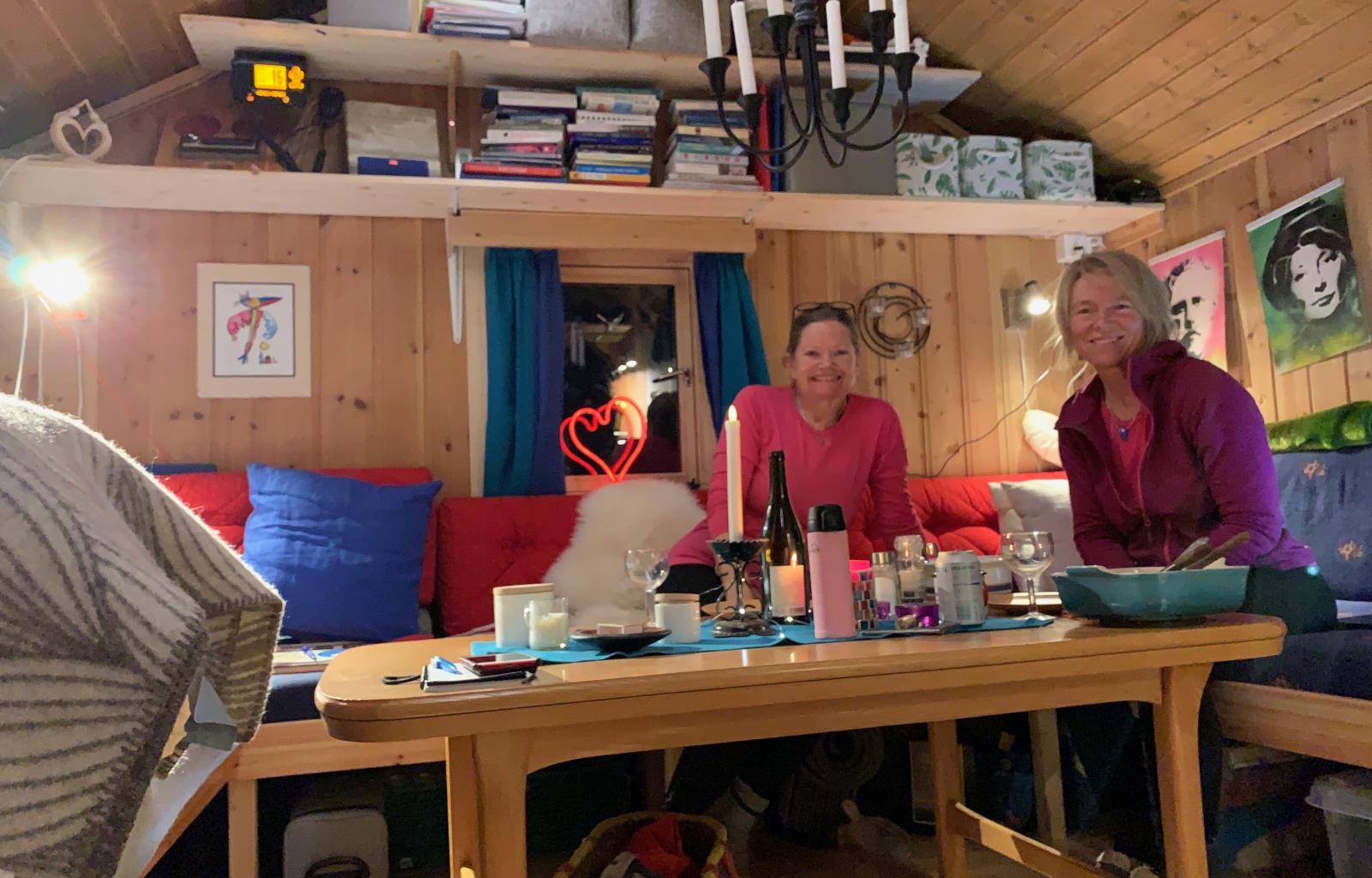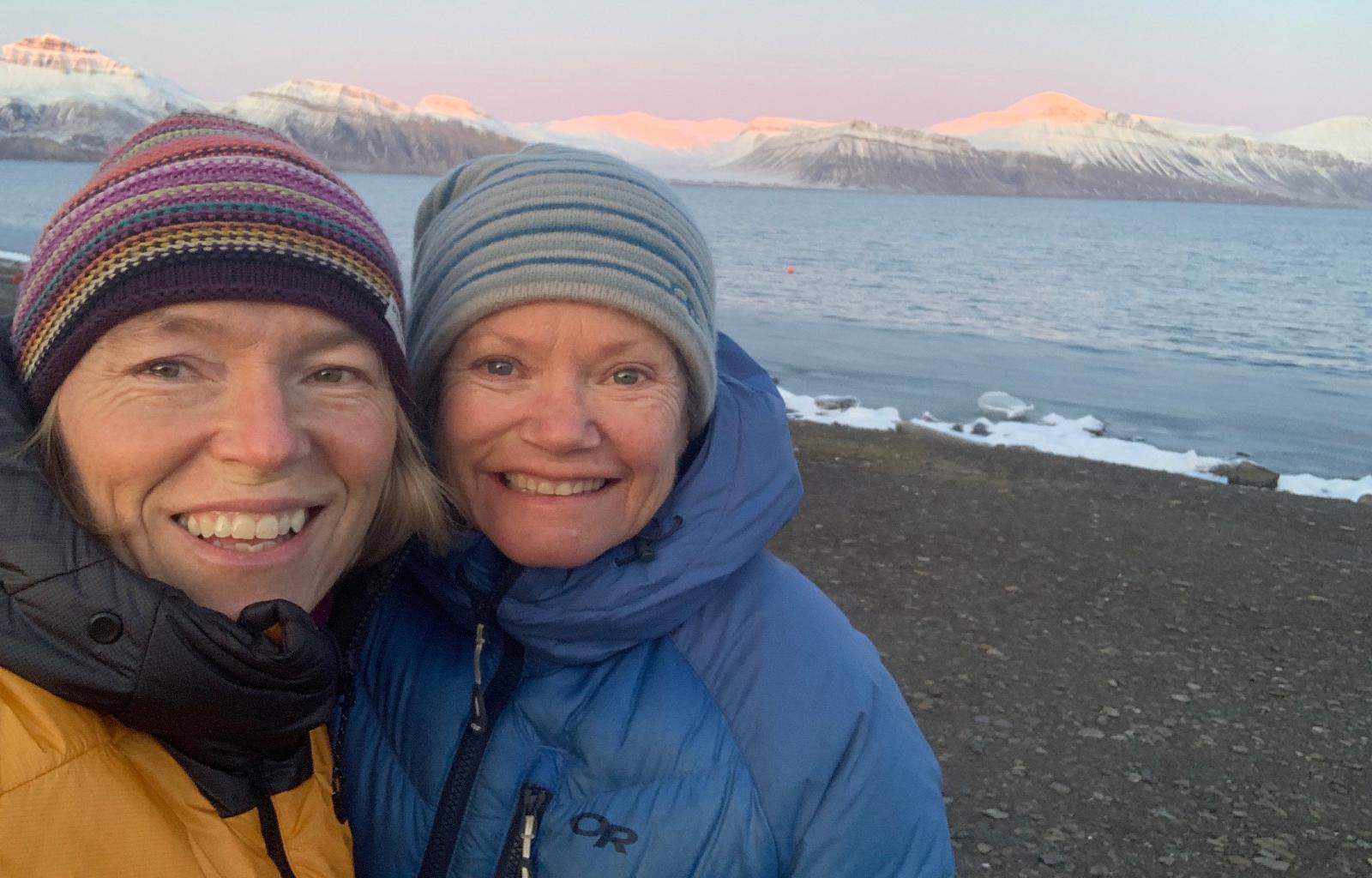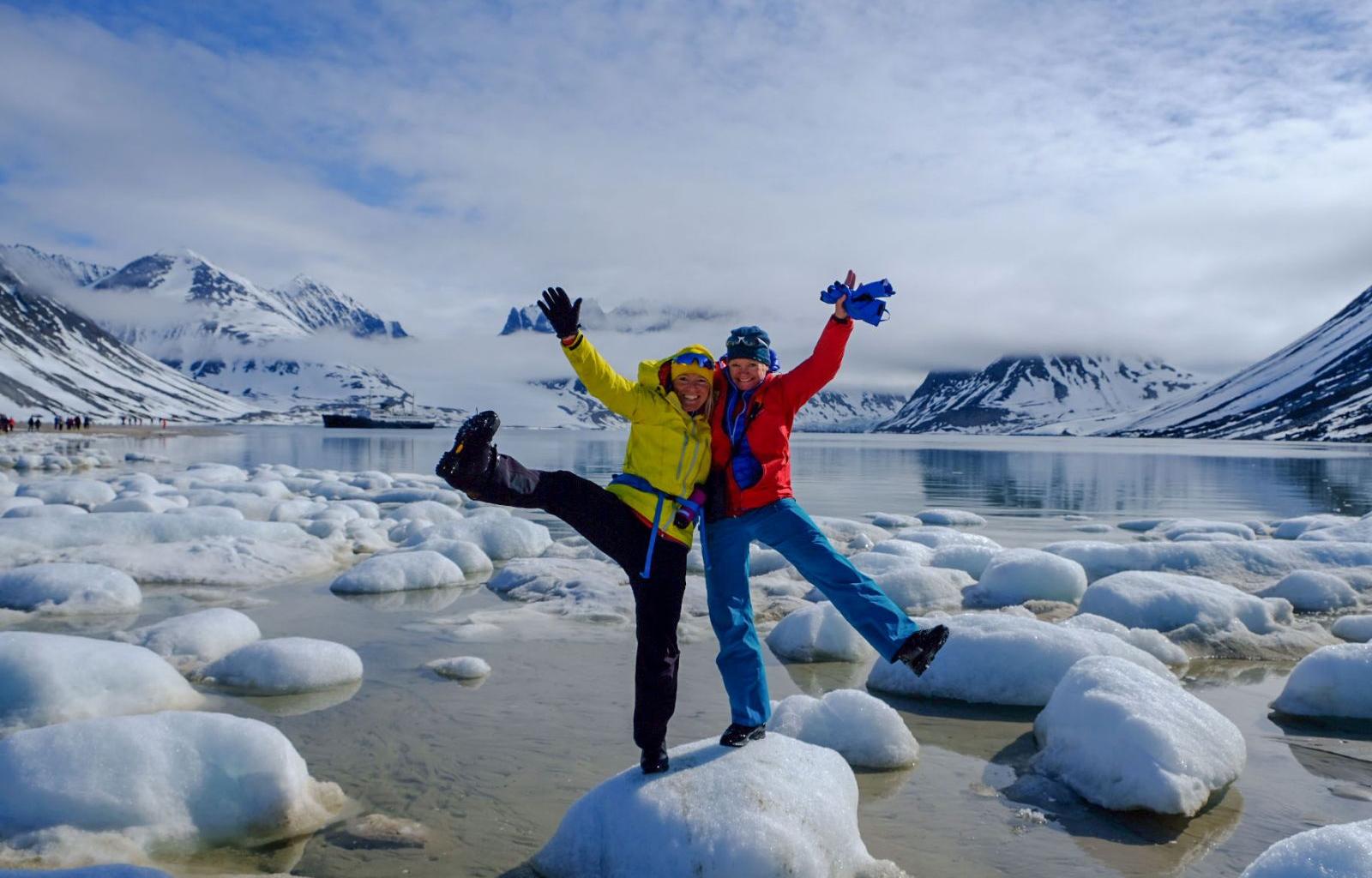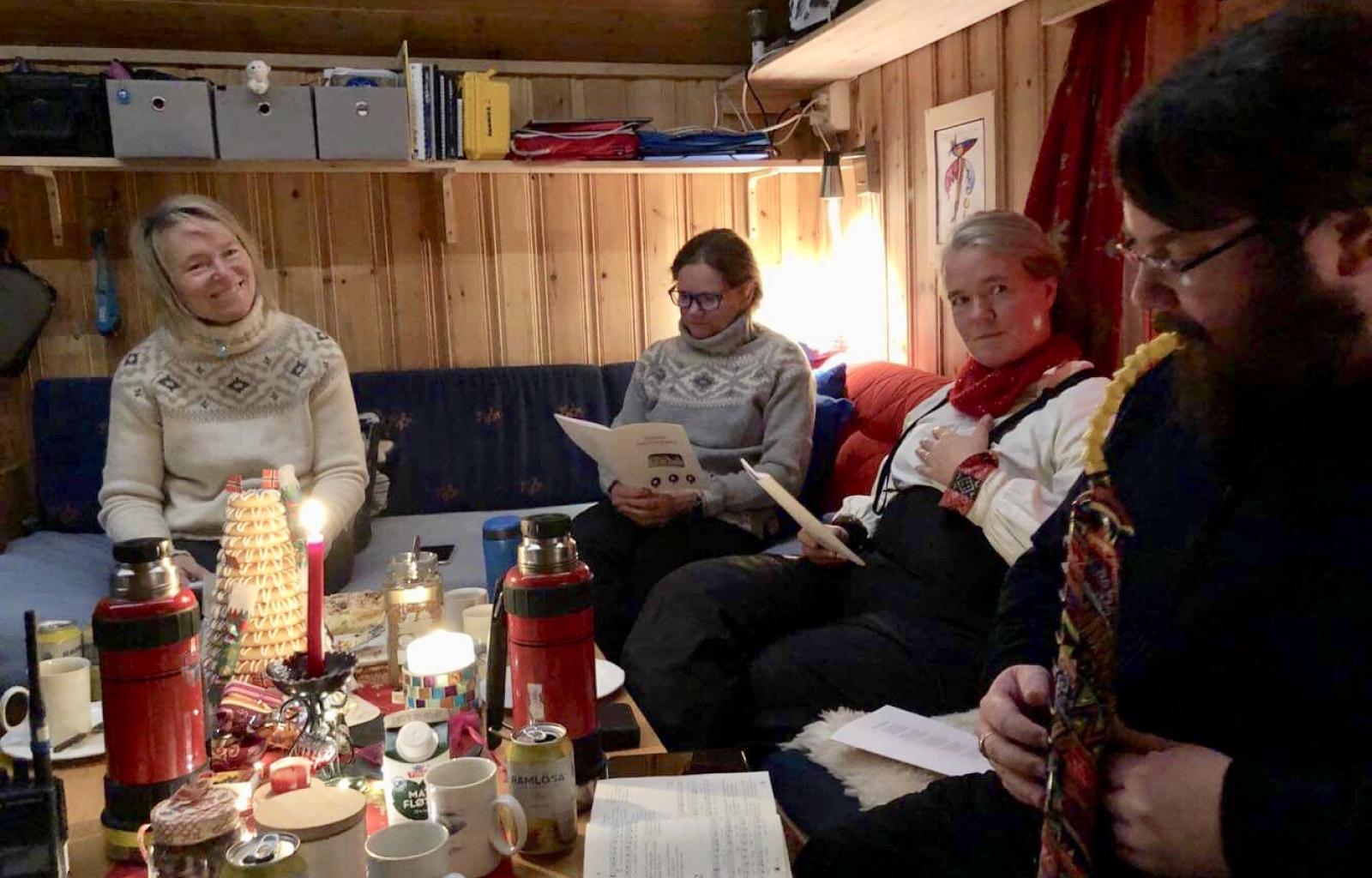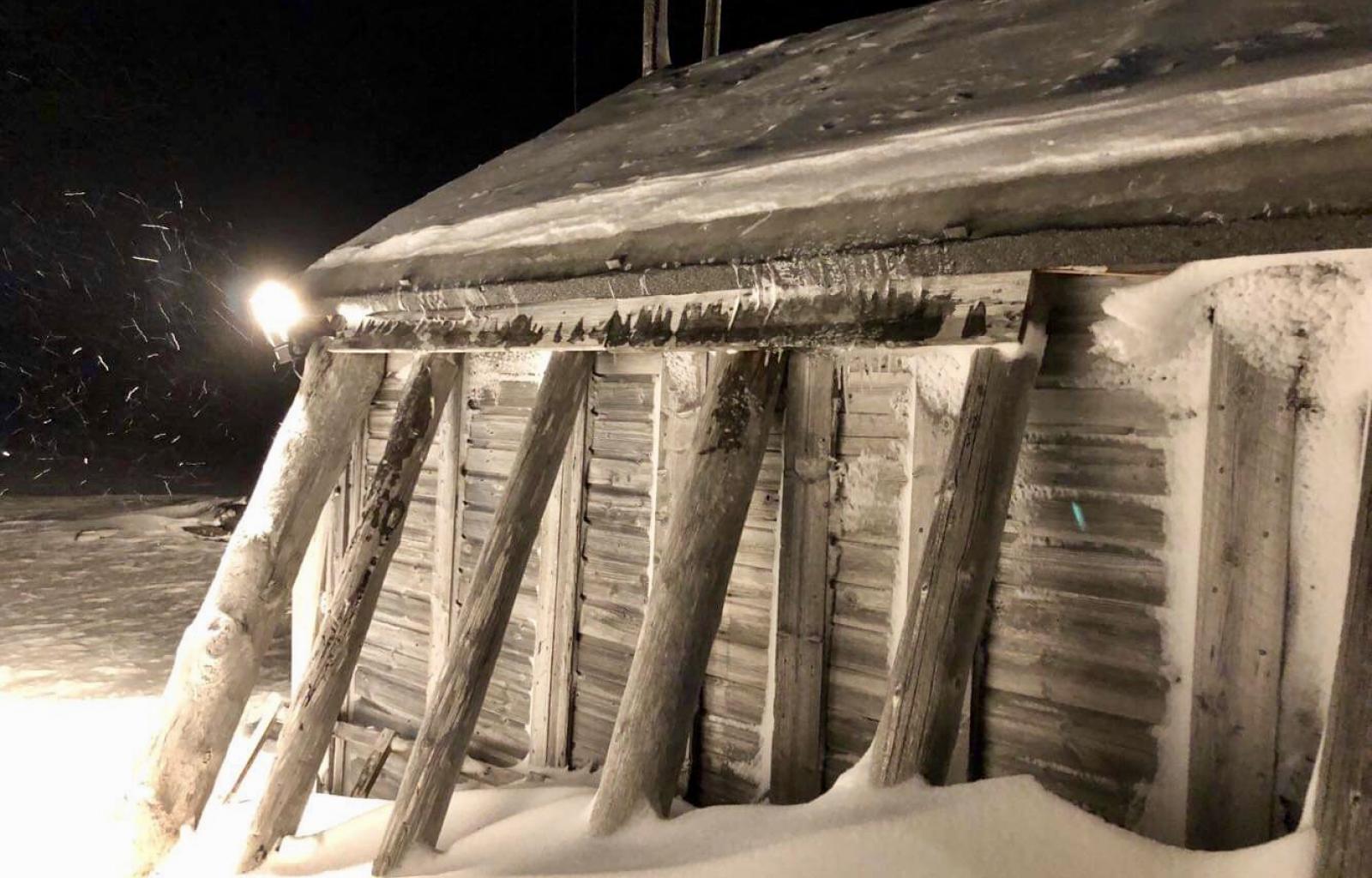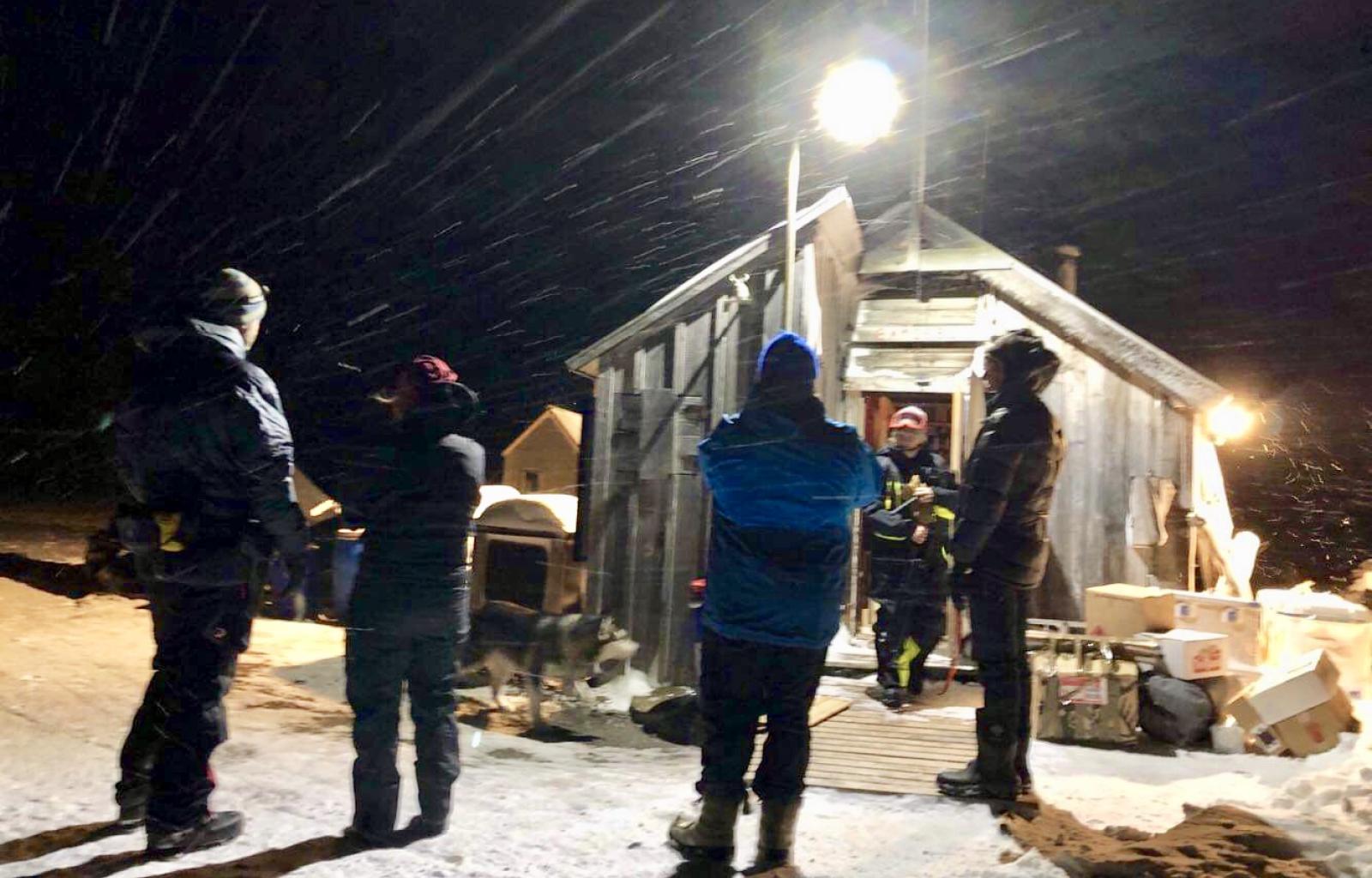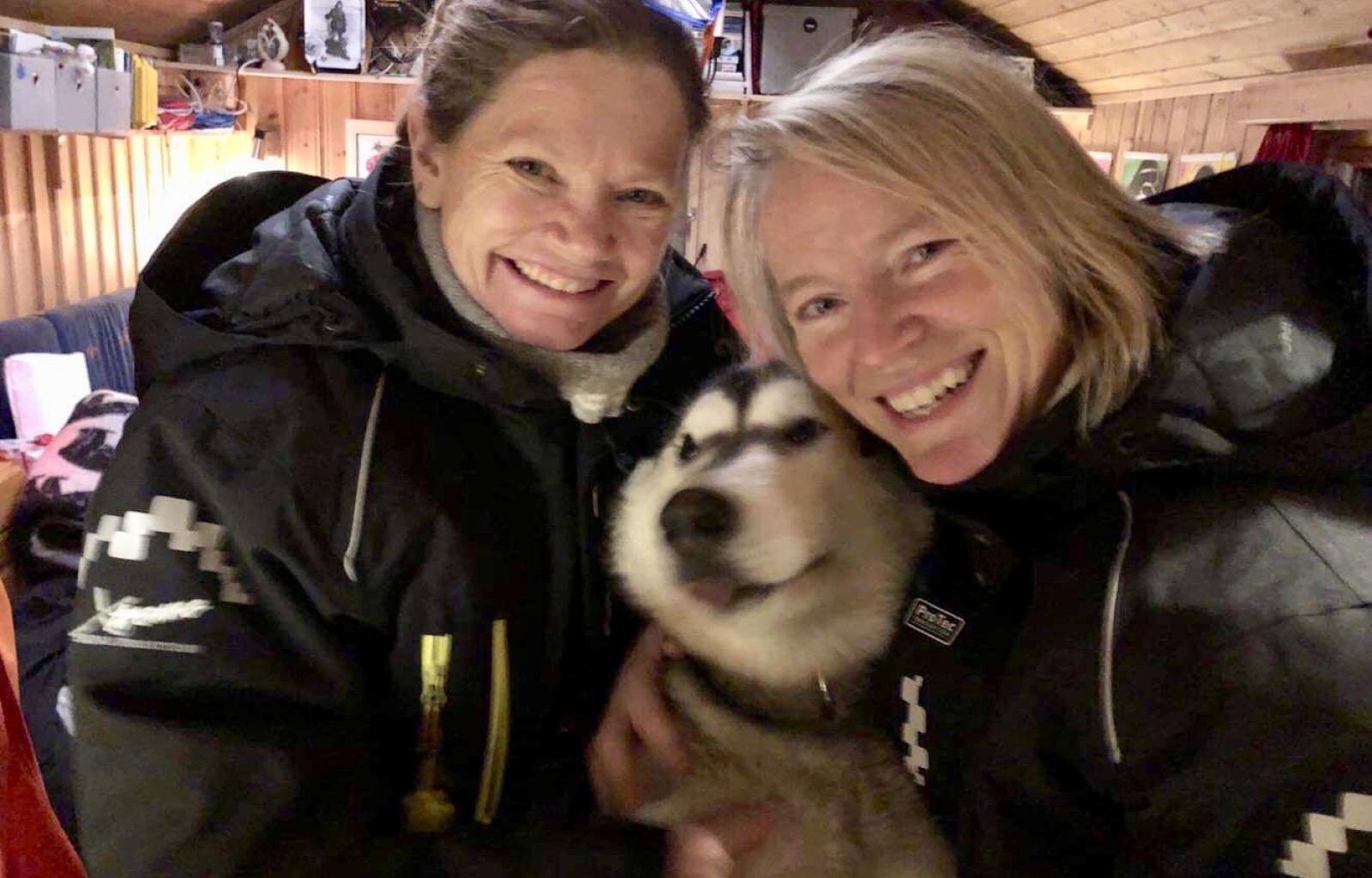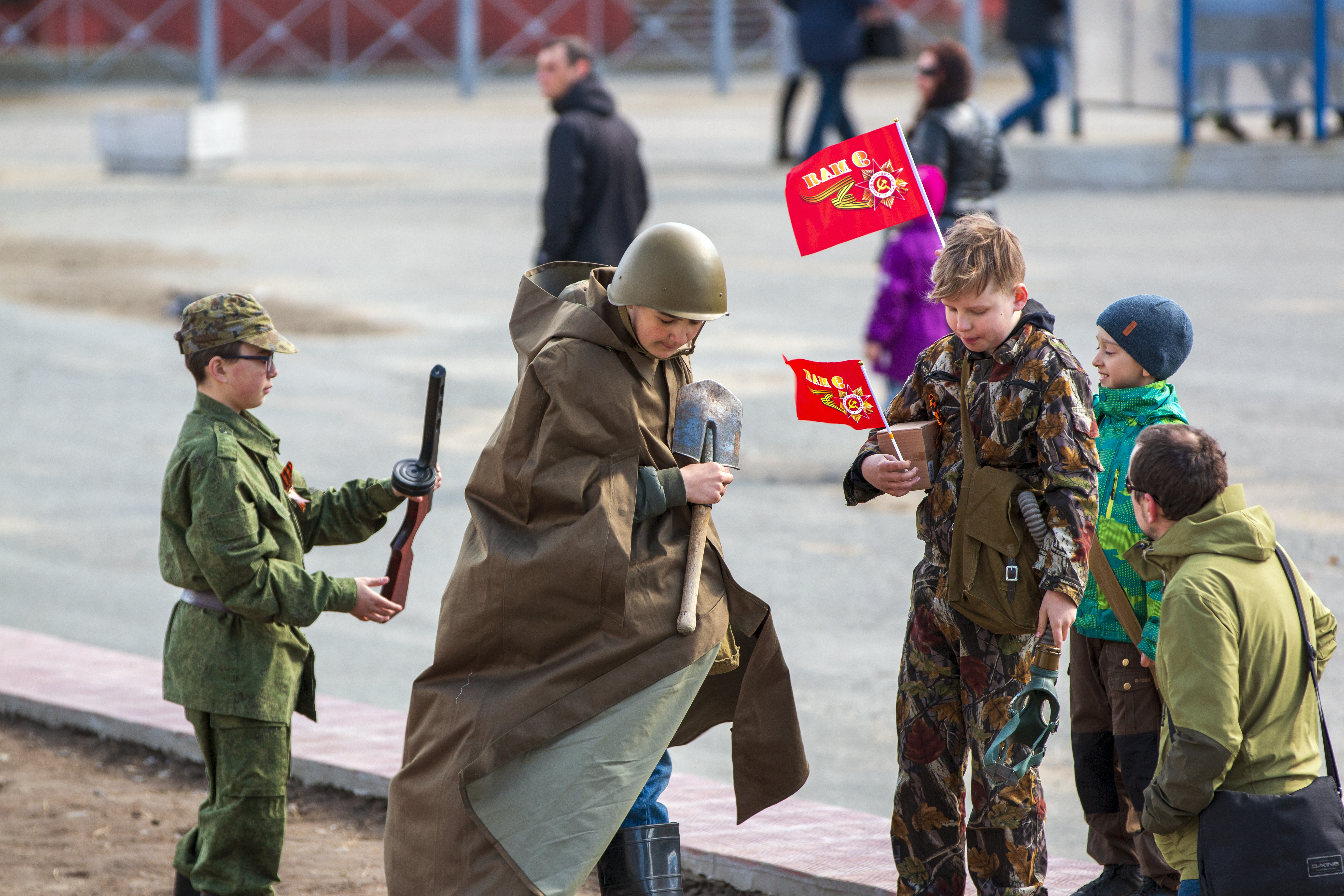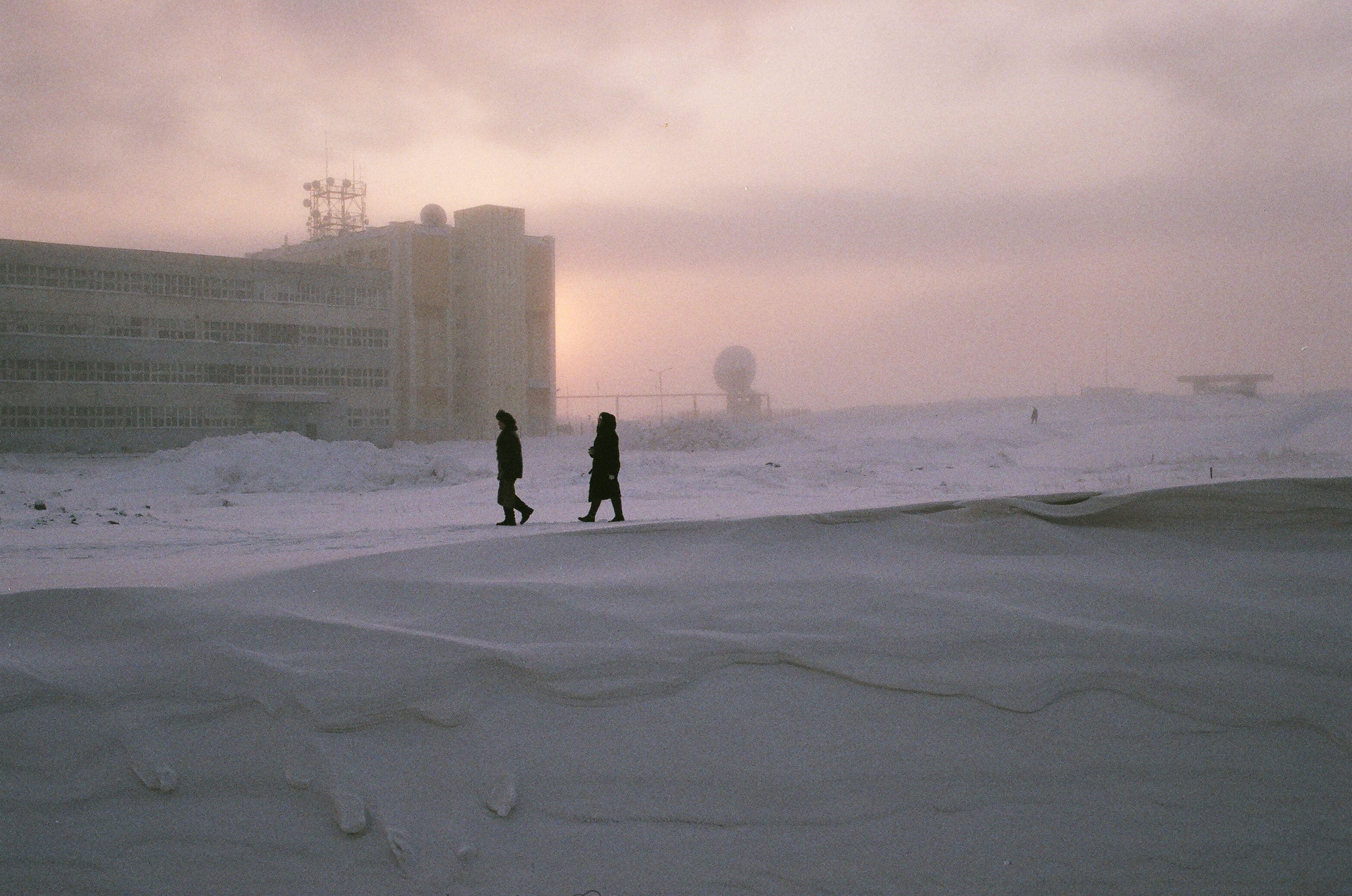Hilde and Sunniva to Celebrate Christmas at 78 Degrees North
Hilde Fålun Strøm, Sunniva Sørby and Ettra the malamute have finished 90 out of 270 days of their overwintering stay at Svalbard. Now they are up for a Christmas beyond the ordinary.
The wind tears and shakes the little trapper cabin 140 kilometers south of Longyearbyen. There are -20 degrees Celsius outside. Inside, Hilde Fålun Strøm and Sunniva Sørby sit before the wood oven to keep warm.
It is dark. Pitch black dark. We are in the kingdom of the polar bear. It is hard to see with bare eyes where the bears are. But they are not far away, as paw tracks on the stairs and around the cabin go to prove.
Several meetings with polar bears
“We often open the door without turning the lights on in order to look at the weather and the northern lights. When we turned the light on, we suddenly saw a polar bear right there, Hilde says to High North News, via a rather poor satellite phone line.
Sunniva expands in their blog: “It happened so fast! I opened the door and three seconds later – there she was! My heart missed a beat. I took a few steps out before turning around to turn on the outdoor lights. She appeared from Ettra’s place, just to the right of the door. Ettra was inside just then. The polar bear threw me a quick glance before she ran down towards the sea and further in along the fjord. I am alert and on guard, always! I hope? Though this was a shock!”
There have been more polar bear meetings. Recently there has been strong winds, snow blowing and complete darkness on Svalbard. The two women were out walking when they stumbled upon a carcass.
“We just saw the contours of something that began running away from us. It was a polar bear that had just killed a reindeer.”
This may be the polar bears’ way of adapting to climate changes. Due to the increasing lack of fjord ice and thus also seals, they have to find alternative food sources.
“Reindeer are a good alternative, however, the polar bear has to learn to hunt these. This polar bear here at Bamsebu had probably lie in wait and waited for the reindeer to come close enough, on a little hilltop just above where the reindeer passed. We saw the tracks. It would not be possible for a polar bear to run after a reindeer, so this method appears far more efficient. But the fact that it had lie in wait is a bit unsettling to think of for us too.”
So far, there has not been conducted any research on this. Børge Damsgård, leader of the UNIS research department commented on the women’s findings via text message:
“No, that is actually quite rare. One knows that polar bears are happy to eat reindeer, however, not hunt them. In the scientific community, we have discussed whether reindeer may prove to be a new food source in relation to climate changes and less sea ice and seals, however, there is not much documentation on this”, he writes.
“It is exciting to know that our pictures and observations can bee important documentation for scientists in bettering the understanding of polar bears’ potential attempts at adjusting to the lack of its usual food source”, Hilde and Sunniva add.
270 days
Christmas is approaching and many have decorated their homes with Christmas lights of various kinds. At Bamsebu, Hilde and Sunniva are approaching a most unusual Christmas, with only the northern lights and each other for company. And the dog, of course.
They have spent nearly 90 days of their overwintering stay at Svalbard and have another 180 days to go. Only in May will they return to their normal lives.
“I think things have gone above and beyond expectations, and it feels amazing. We are living a dream we have had for so many years. Of course, there are a lot of challenges and bumps in the road here and there. These days, the darkness places limitations on us. However, we think things are going great”, they say.
High North News has written about their expedition, the project “Hearts in the Ice”, before.
- Also read: Two women, 9 months, 78 degrees North
Their overwintering stay is basically about two women living in a trappers’ cabin from 1930, on 78 degrees North, for nine months. There they will operate as so-called “citizens’ scientists”, which will be their contribution in the struggle for nature and the climate changes the world is facing. Along with a series of partners and sponsors, an important part of their stay will be sharing experiences and knowledge they accumulate through living completely isolated and in keeping with nature.
On Friday 13 September, they left Longyearbyen, where more than a hundred people had turned up to say goodbye.
“We have been very active and it feels very meaningful, as ordinary people, to be allowed to contribute to important climate research. We are well underway with a series of exciting project, such as e.g. one bout fytoplankton, they say.
Citizens’ science
Fytoplankton is a plankton that in addition to being an important food source in the ocean also produced more than half the world’s oxygen, actually more than all rainforest combined.
“It goes without saying that it is extremely important. However, the fytoplankton that lives up here in the north does not like warmer waters and the sweetness levels the water acquires from increased glacial melting. Nor does fytoplankton have the ability to swim, so it cannot move further north, like the polar cod. It is very exciting to watch what happens to it, in particular to find out whether it produced oxygen during the dark season and under the full moon and northern lights, they tell us.
The two women have also been adopted as “Rocket citizen scientists” by research stations in Andøya and Ny-Ålesund. Because Svalbard has a favorable location when it comes to observing daytime northern lights. Also, there is no light pollution at Bamsebu.
“The launch window is up until 14 December. And each morning we wait for signals about whether to go out and photograph. The rockets that are launched initiate an artificial northern light while there is also daytime northern lights activity, and there has to be a match between both the weather in Ny-Ålesund and on Andøya, as well as with the wind and northern light activities. The reactions these materials create when launched into the atmosphere can tell much about how particles behave in our atmosphere, the two rocket scientists say with enthusiasm.
NASA also uses the two women for its northern lights research and they work on gathering data for a project called “Aurorasaurus”.
In addition, they operate drones to map temperature both on the ocean surface as well as in the ground, they make animal observations for UNIS, and they participate in an ocean plastics project run by the Norwegian Polar Institute – amongst much else.
- Life takes time here at Bamsebu, as we do not have water nor electric power. At present, we have a break from boat riding as there is much ice. However, we manage to fill the days, they say.
Close to nature – and each other
Prior to their expedition, the two were somewhat worried about access to water and wood.
- Also read: One week into their overwintering stay at Svalbard, Hilde and Sunniva have already faced challenges
They had brought a water container from Longyearbyen and have been good at collecting water and also glacial ice that has drifted towards land.
“There has also been surprisingly much snow, more than usual, so we have plenty of water. We have also spent the autumn gathering wood, both on food, by boat and with snowmobile. We cannot be sure, but we believe we have enough. And when the sun and light return, it will also be easier to find our way around the terrain and collect more.”
Half way into December, the polar night is present 24/7, and there is a lot of weather and wind. The trappers’ cabin from 1930 is not insulated for winter conditions.
“The cabin works, however, it is not insulated, so it does not quite stay warm. We can feel it with the winds blowing like now, though we have solid clothes and a brand-new wood oven that works really well. All the drift wood is not dry and it does not always provide solid heating, but we manage”, they assure us.
Another thing they were curious about was how they would manage to live so close for such a long period of time, without seeing other people or having the opportunity to withdraw for a while.
To be frank, we thought it would be more difficult than what it has proven to be.
“We knew each other well from before, but had not spent more than 14 days together in one go. But we have tremendous respect for one another and we are good friends. To be honest, we expected it to be more difficult than what it has proved to be”, they say. Nevertheless, they acknowledge:
“There have been some bumps in the road, of course, but we had great help beforehand with two coaches who helped us getting to know ourselves better and who equipped us with tools to manage communication. So all in all, it goes above and beyond expectations”.
In their own little bubble
The two women are equipped with a satellite phone so that they can stay in touch with their respective families. However, they use the communications equipment primarily for the job that they are out to do. Thus, they do not quite have an overview over the media coverage they have received this fall and winter.
It has been massive. Both Norwegian media, such as VG, Svalbardposten, Teknisk Ukeblad and Folkebladet, Swedish Point of Value, as well as Scandinavia Traveller have covered their expedition. Foreign media coverage includes The Guardian, Danish Information, Canadian CBC, Canadian Geographic, The Squamish Chief and Le Journal Access – to mention but a few.
“We kind of live inside our own little bubble and do not quite follow this. We have noted that we have received some coverage and hope that it is of the positive kind, however, we are not online to download stories and read about ourselves. We do want attention about the issues we are here to highlight, most current themes and issues we want to learn more about and inspire everyone to do something about”, they say and state:
“We see massive changes and the balance is definitely off. There was an Arctic desert when we arrived, today we have more snow than usual. But we do not want to contribute to climate anxiety or cause fear. Our goal is to inspire and highlight the positive impact it may have if we all contribute.”
We do not want to contribute to climate anxiety or cause fear. Our goal is to inspire and highlight the positive impact it may have if we all contribute
Connecting from pole to pole
However, the Arctic is not the only place where women meet to inspire change. While Hilde and Sunniva live at 78 degrees North, 100 women are gathered on the opposite side of the globe.
Organized by “Homeward bound”, a leadership development program for female researchers aiming to change climate policies, 100 female scientists from 35 countries were on an expedition in Antarctica from 22 November to 10 December. Hilde and Sunniva spoke with the delegation from the opposite side of the globe.
“It was a very special encounter. We sat at opposite sides of the globe and worked out a strategy for how to engage more women all over the world so that we together can push current developments in the right direction. There are amazing resources in that network and more than 1,000 women globally are part of it.”
Hilde and Sunniva make no secret of the fact that it gave them an additional boost to be able to connect across both across distances and longitude.
“Even if they were on a boat deck under the midnight sun and we were in utter darkness, we shared a sense of fellowship. Despite major difference and utter extremes, we wee massive changes in both places.”
A most extraordinary Christmas
It is Friday and Christmas is approaching fast. There is little doubt that this year’s Christmas will be something out of the ordinary for Hilde Fålun Strøm and Sunniva Sørby. They have recently received word that the weather will prevent a long-planned refill of supplies.
Yet then comes the distinct sound of flapping rotors. It is the Svalbard Governor’s Christmas helicopter that is visiting from Longyearbyen.
The helicopter carries priest Siv S. Limstrand and organist Jovna Z. Dunfjell from Svalbard church, Steinar Strøm, Hilde’s husband, as well as Aud Andersen and Leif Aren Nilsen from the Svalbard Governor’s office.
Well inside the cabin, which is almost covered by snow, red candles are lit and cake and coffee appear on the table. Some Christmas cakes, Christmas songs and reading of the Christmas story from the Bible is also allowed, now with the advent season well underway. The organist could not fit his instrument into the helicopter, however, he brought a melodica to create proper Christmas atmosphere.
The Governor has brought a generous box of fruit, a chocolate praline box and other delicacies. But perhaps most important of all; a solid rib steak for Hilde and Sunniva to enjoy on Christmas Eve.
“We had a vacuum-packed rib steak just in case, so there would definitely be Christmas, but now the season will have that extra little touch to it”, they say in closing.

